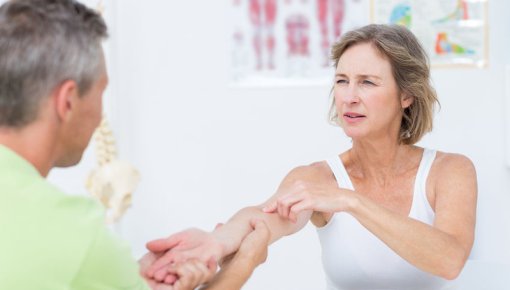Ahmad Z, Siddiqui N, Malik SS et al. Lateral epicondylitis: a review of pathology and management. Bone Joint J 2013; 95-B(9): 1158-1164.
Barreto ES, Antunes Junior CR, Alencar VB et al. The efficacy of Botulinum Toxin in Tennis Elbow: a meta-analysis of randomized clinical trials. Int Orthop 2024; 48(12): 3139-3149.
Bisset L, Coombes B, Vicenzino B. Tennis elbow. Clin Evid 2011: 1117.
Buchbinder R, Johnston RV, Barnsley L et al. Surgery for lateral elbow pain. Cochrane Database Syst Rev 2011; (3): CD003525.
Chou LC, Liou TH, Kuan YC et al. Autologous blood injection for treatment of lateral epicondylosis: A meta-analysis of randomized controlled trials. Phys Ther Sport 2016; 18: 68-73.
Coombes BK, Bisset L, Vicenzino B. Efficacy and safety of corticosteroid injections and other injections for management of tendinopathy: a systematic review of randomised controlled trials. Lancet 2010; 376(9754): 1751-1767.
Dingemanse R, Randsdorp M, Koes BW et al. Evidence for the effectiveness of electrophysical modalities for treatment of medial and lateral epicondylitis: a systematic review. Br J Sports Med 2014; 48(12): 957-965.
Dion S, Wong JJ, Côté P et al. Are Passive Physical Modalities Effective for the Management of Common Soft Tissue Injuries of the Elbow? A Systematic Review by the Ontario Protocol for Traffic Injury Management (OPTIMa) Collaboration. Clin J Pain 2017; 33(1): 71-86.
Dong W, Goost H, Lin XB et al. Injection therapies for lateral epicondylalgia: a systematic review and Bayesian network meta-analysis. Br J Sports Med 2016; 50(15): 900-908.
Karanasios S, Korakakis V, Whiteley R et al. Exercise interventions in lateral elbow tendinopathy have better outcomes than passive interventions, but the effects are small: a systematic review and meta-analysis of 2123 subjects in 30 trials. Br J Sports Med 2021; 55(9): 477-485.
Karanasios S, Tsamasiotis GK, Michopoulos K et al. Clinical effectiveness of shockwave therapy in lateral elbow tendinopathy: systematic review and meta-analysis. Clin Rehabil 2021; 35(10): 1383-1398.
Karjalainen TV, Silagy M, O'Bryan E et al. Autologous blood and platelet-rich plasma injection therapy for lateral elbow pain. Cochrane Database Syst Rev 2021; (9): CD010951.
Kim YJ, Wood SM, Yoon AP et al. Efficacy of Nonoperative Treatments for Lateral Epicondylitis: A Systematic Review and Meta-Analysis. Plast Reconstr Surg 2021; 147(1): 112-125.
Krogh TP, Bartels EM, Ellingsen T et al. Comparative effectiveness of injection therapies in lateral epicondylitis: a systematic review and network meta-analysis of randomized controlled trials. Am J Sports Med 2013; 41(6): 1435-1446.
Loew LM, Brosseau L, Tugwell P et al. Deep transverse friction massage for treating lateral elbow or lateral knee tendinitis. Cochrane Database Syst Rev 2014; (11): CD003528.
Mattie R, Wong J, McCormick Z et al. Percutaneous Needle Tenotomy for the Treatment of Lateral Epicondylitis: A Systematic Review of the Literature. PM R 2017; 9(6): 603-611.
Menta R, Randhawa K, Côté P et al. The effectiveness of exercise for the management of musculoskeletal disorders and injuries of the elbow, forearm, wrist, and hand: a systematic review by the Ontario Protocol for Traffic Injury Management (OPTIMa) collaboration. J Manipulative Physiol Ther 2015; 38(7): 507-520.
Moraes VY, Lenza M, Tamaoki MJ et al. Platelet-rich therapies for musculoskeletal soft tissue injuries. Cochrane Database Syst Rev 2014; (4): CD010071.
Navarro-Santana MJ, Sanchez-Infante J, Gomez-Chiguano GF et al. Effects of manual acupuncture and electroacupuncture for lateral epicondylalgia of musculoskeletal origin: a systematic review and meta-analysis. Acupunct Med 2021; 39(5): 405-422.
Olaussen M, Holmedal O, Lindbaek M et al. Treating lateral epicondylitis with corticosteroid injections or non-electrotherapeutical physiotherapy: a systematic review. BMJ Open 2013; 3(10): e003564.
Orchard J, Kountouris A. The management of tennis elbow. BMJ 2011; 342: d2687.
Pattanittum P, Turner T, Green S et al. Non-steroidal anti-inflammatory drugs (NSAIDs) for treating lateral elbow pain in adults. Cochrane Database Syst Rev 2013; (5): CD003686.
Qian X, Lin Q, Wei K et al. Efficacy and Safety of Autologous Blood Products Compared With Corticosteroid Injections in the Treatment of Lateral Epicondylitis: A Meta-Analysis of Randomized Controlled Trials. PM R 2016; 8(8): 780-791.
Raman J, MacDermid JC, Grewal R. Effectiveness of different methods of resistance exercises in lateral epicondylosis - a systematic review. J Hand Ther 2012; 25(1): 5-25; quiz 26.
Tang H, Fan H, Chen J et al. Acupuncture for Lateral Epicondylitis: A Systematic Review. Evid Based Complement Alternat Med 2015: 861849.
Wallis JA, Bourne AM, Jessup RL et al. Manual therapy and exercise for lateral elbow pain. Cochrane Database Syst Rev 2024; (5): CD013042.
IQWiG-Gesundheitsinformationen sollen helfen, Vor- und Nachteile wichtiger Behandlungsmöglichkeiten und Angebote der Gesundheitsversorgung zu verstehen.
Ob eine der von uns beschriebenen Möglichkeiten im Einzelfall tatsächlich sinnvoll ist, kann im Gespräch mit einer Ärztin oder einem Arzt geklärt werden. Gesundheitsinformation.de kann das Gespräch mit Fachleuten unterstützen, aber nicht ersetzen. Wir bieten keine individuelle Beratung.
Unsere Informationen beruhen auf den Ergebnissen hochwertiger Studien. Sie sind von einem Team aus Medizin, Wissenschaft und Redaktion erstellt und von Expertinnen und Experten außerhalb des IQWiG begutachtet. Wie wir unsere Texte erarbeiten und aktuell halten, beschreiben wir ausführlich in unseren Methoden.

